

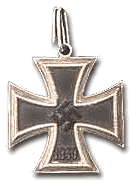
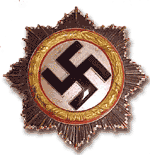
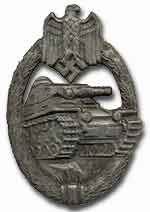
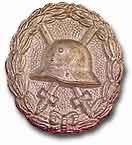
SS-Sturmbannführer
Leo Reinhold
II./SS-Pz.Abt.10
10.SS-Pz.Div. "Frundsberg"
II.SS-Pz.Armeekorps
Träger
des Ritterkreuz des Eiserne Kreuze (no.3813)






In the Fight
Against Allied Airborne Units
in Arnheim and Nijmegen
17-26 September 1944
After 1300 hours on 17 September, the great American and British airborne operation "Market Garden" began over Holland. Airborne landings were made by the U.S. 101st "Screaming Eagles" Airborne Division in the area of Eindhoven-Veghel, the U.S. 82nd "All American" Airborne Division in the area of Grave-Nijmegen, and the British 1st Airborne Division at Arnheim. At the approximate same time, British armored forces (XXX Corps) attacked north from out of the bridgehead at Neerpelt.
The great battle around the area of Arnheim-Nijmegen began for the II.SS-Pz.A.Korps. From the staff quarters in Doetinchem, the II.SS-Pz.A.K. alerted the 10.SS-Pz.Div. and 9.SS-Pz.Div. (the 9.SS was in the process of returning to Germany) after receiving the first reports of Allied airborne landings. The commander of the 10.SS-Pz.Div., Heinz Harmel, located at the SS-Führungshauptamt in Bad Saarow, obtained orders by telegram to return to his troops. Meanwhile, around 1600 hours, the 10.SS-Pz.Div. (Major Paetsch, commander of the SS-Pz.Rgt.10, functioned as the intermediate commander) obtained orders from the corps to proceed immediately over Arnheim to Nijmegen, occupy both bridges over the Waal River, and establish and hold a bridgehead south of the city. All applicable German troops in the vicinity of Nijmegen were to attached themselves to the division.
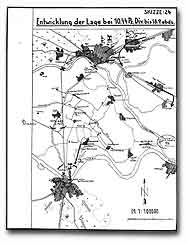
click map for high-res enlargement
The SS-Pz.Aufkl.Abt.9 (Führer Gräbner), comprised of approximately 30 armored half tracks and scouting vehicles, was attached to the 10.SS-Pz.Div. to conduct reconnaissance from Arnheim to Nijmegen. In exchange, the 10.SS-Pz.Div. released their own reconnaissance section (Führer Brinkmann) to the Kampfgruppe 9.SS-Pz.Division.
At approximately 1800 hours, the SS-Pz.Aufkl.Abt.9 arrived at the city of Arnheim, broke through weak defenses at the bridge over the lower Rhein (Niederrhein) and continued in the direction of Nijmegen.
The SS-Pz.Aufkl.Abt.10 reconnoitered toward Arnheim, traveling over Emmerich and against Nijmegen, and in the direction of Wesel where Allied airborne drops were reported. Around 1900, the 1.Pz.Späh.Kp., scouting toward Arnheim, reported the Arnheim bridge at in Allied hands and its reinforcement to the intermediate divisional commander (enroute from Ruurlo to Velp with elements of the command staff). The Allies gained considerable strength through the control of flak bunkers next to the bridge. Soon after, additional elements of the SS-Pz.Aufkl.Abt.10 arrived in Arnheim. The section commander Brinkmann (SS-Pz.Aufkl.Abt.10) was ordered to attack with the attached Kampfgruppe SS-Pz.Div.9 (Führer Oberstleutnant Harzer), destroy the enemy at the northern approach of the bridge and open the divisional route of advance to Nijmegen. For this task, the section was placed under orders of Kampfgruppe Spindler, of the 9.SS-Pz.Division.
By the evening on 17 September,
Major Paetsch ordered the formation of Kampfgruppe Reinhold to follow the SS-Pz.Aufkl.Abt.9
onto Nijmegen. Kampfgruppe Reinhold was commanded by the very able and experienced
SS-Sturmbannführer Leo Reinhold, commander of the II./SS-Pz.Abt.10.
Leo Reinhold was born on 22 February 1906 in the Prussian capital city of Königsberg. In 1928, Reinhold joined the police as a candidate and transferred to the Wehrmacht in 1935. As an Oberleutnant in the Army Schützenpolizei, he returned to a municipal police force in January 1939, only to return to active military duty one month later, as a Panzerjäger-Kompanie (anti-tank company) commander in the SS-Polizei-Division. In June 1940, during the campaign in the west, Reinhold earned the Iron Cross II. Class. In the east, in September 1941, he received the Iron Cross I. Class and qualified to wear the wound badge in silver. On 10 March 1943, Reinhold was transferred to the Frundsberg Division as a battalion commander in the Panzerregiment 10.
Coincidentally, on 17 September 1944, Reinhold was awarded the German Cross in Gold for his exploits in the east at Buczacz and Pilwa, in the west around Caen at Hill 112, Esquay, and Hill 188.
The Kampfgruppe was comprised of the SS-Pz.Gren.Btl.Euling, which had been released several days earlier from the 9.SS to the 10.SS-Pz.Div., the II./SS-Pz.Rgt.10 (16-20 PzKpfw IV), 1 Abt. of the SS-Pz.Artl.Abt.10 (1 Feldhaubitze), and 1 Kp. of the SS-Pz.Pi.Btl.10.
Throughout the period from 18-21 September, SS-Sturmbannführer Leo Reinhold provided the spirit and soul for the 3-day defense at the bridgehead at Nijmegen. Despite very high loses suffered by his men and the adhoc addition of unknown German troop elements, Reinhold effectively rallied the defense against superior Allied armored forces and closed several critical gaps that developed during the fighting. Reinhold's men accounted for the close-quarter destruction of 24 Allied tanks. On orders to recapture the bridgehead, Reinhold led, by example, to contain the wavering defensive line and personally led a counterattack to establish a blocking line along the north bank of the Waal. Not only did Reinhold prevent an Allied breakthrough from the bridgehead at Nijmegen to Arnheim, but he also provided the necessary time for the obliteration of Allied airborne forces at Arnheim. For his achievements, SS-Sturmbannführer Reinhold was decorated on 16 October 1944 as the 3,813th recipient of the Knight's Cross to the Iron Cross.

Copyright Stenger
Historica 2004